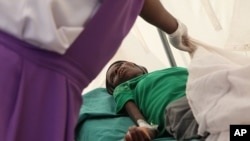The World Bank says significantly better HIV prevention efforts are needed in Africa. It says a slow global economy and uncertain donor aid make preventing new infections a necessity.
A new World Bank report says the world’s economic woes are causing “anxiety about maintaining and expanding AIDS treatment programs in low income countries.”
Co-author Elizabeth Lule said concerns about tight budgets coincide with much progress being made against the disease.
“HIV prevalence, especially among young people, is going down in southern Africa. In countries where there’s highest burden, young people have better knowledge. They’re using condoms consistently. They’re reducing partners. So there is a lot of progress,” she said.
Also in recent years, studies have shown that giving antiretroviral drugs to HIV negative people can protect them from becoming infected. And there’s been progress in vaccine research, although an effective vaccine is still considered years away.
Fiscal dimension
“We shouldn’t just be looking at HIV/AIDS as a health problem, but also as an economic problem because of the huge costs that are incurred in treating people as well as prevention. And we highlight the importance of continuing to use effective prevention in order to contain future costs,” she said.
The report is called The Fiscal Dimension of HIV/AIDS in Botswana, South Africa, Swaziland and Uganda.
“There’s been very limited analysis on the fiscal dimension of HIV/AIDS for countries to understand the future liability that they take on, especially if they do not reduce new infections. They would only be adding to the burden,” she said.
Lule, the World Bank’s acting director for regional integration in Africa, said treating HIV/AIDS can only be done on a long term basis.
“When a person gets HIV/AIDS it usually takes a number of years before they develop full-blown AIDS. But then once you put them on treatment you cannot stop. And they may survive, of course, for a long time and the countries have to incur those costs. And then the more new infections you have the more people you have to treat in the future. And therefore the higher costs that countries would have to incur,” she said.
But while the World Bank calls for significantly better HIV prevention efforts, it does not propose specific ways to do that.
Lule said, “There isn’t any HIV strategy that works effectively everywhere. Countries have to understand and know their epidemic. In countries like Uganda, Brazil and Thailand, where they had a lot of success in reducing HIV infections, it was mainly using a combination of behavior interventions, biomedical interventions, as well as structural interventions that look at the underlying causes.”
Cost per infection
The study tries to calculate how much money a country would save if it prevented one HIV infection. For example, it says Uganda would save nearly $6,000 for each new infection that was prevented. South Africa could save $2,500 per infection.
“So it’s a huge saving if they really did prevention more effectively. And then they would be able to afford maintaining the treatment as well as investing in prevention,” she said.
Lule said countries with poor health systems or a shortage of health workers may face challenges strengthening their prevention efforts. She added effective programs will require partnerships involving governments, donors and people living with HIV.
What’s more, the World Bank official says even without a global recession, available resources must be used effectively and efficiently in the future. Currently, more than 6 and a half million people are receiving treatment for HIV/AIDS, but about 30 million are currently living with the disease.














